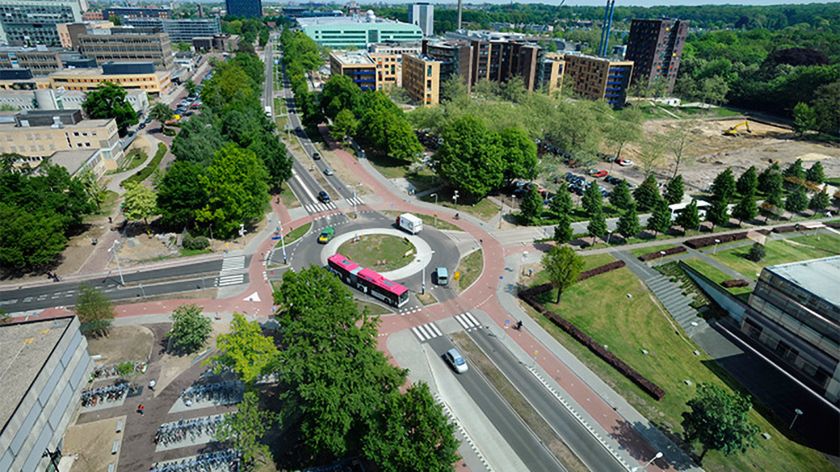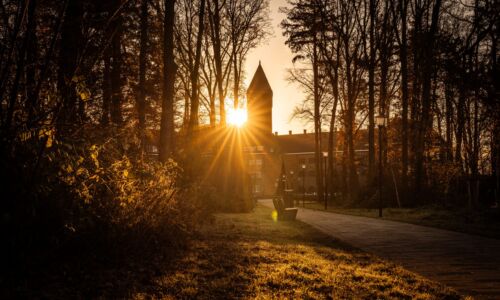Cars to disappear from (parts of) Erasmuslaan and Heyendaalseweg
-
 Roundabout on Heyendaalseweg. Photo: Bert Beelen
Roundabout on Heyendaalseweg. Photo: Bert Beelen
The Erasmuslaan and Heyendaalseweg will be closed to through-traffic by 2026. Before then, car use around campus will need to fall by 20 percent. These are the aims of a multi-year mobility plan drawn up by Radboud University, Radboud university medical center, the local council and other partners.
Although hard to imagine at present, the last kilometre of the route to campus was extremely busy before the coronavirus crisis. In total, some 50,000 students and 17,000 employees from Radboud University, Radboud university medical center, HAN University of Applied sciences and ROC travelled to Heyendaal every day. It was especially congested during rush hour, resulting in unsafe traffic conditions. In the past, there have been several accidents at the roundabout on the Erasmuslaan.
Heavy traffic is set to return when the coronavirus pandemic is over. The Sustainable and Accessible Heyendaal project group made up of Radboud University, Radboud university medical center and other partners has put forward a plan to regulate traffic flows, improve safety and make the campus greener (see box).
Less asphalt, more green
The boldest step is that a few years from now cars travelling from the city to the campus along the Heyendaalseweg will not be able to go further than the Huygens building. Cars will only be welcome on the section of the Erasmuslaan between the Sint-Annastraat and the Grotius building in order to access the parking garage. The rest of the road will be earmarked for cyclists, buses and emergency services.
It is not yet decided whether buses will run in one or both directions across the campus. ‘The less asphalt we have, the more green spaces we’ll get,’ says Carlo Buise of the Occupational Health & Safety and Environment Service. ‘Ideally, we’d like a park with a bus going through it.’ Those wanting to park their car on campus will be diverted along the Driehuizerweg or Sint-Annastraat.
‘Ideally, we’d like a park with a bus going through it’
To achieve this plan, all partners have set themselves the goal of reducing the number of cars coming to campus by 20 percent. ‘We don’t want to divert car traffic from the campus to the rest of the city,’ explains Buise. ‘The Sint-Annastraat might be able to handle those traffic volumes, but some intersections near campus can’t.’
‘The experience we’ve now gained with working from home can help us here,’ says Buise. ‘If everyone works from home one day a week after the coronavirus crisis, this will already reduce traffic to campus by 20 percent.’
Electric share cars
Flexible parking fees and promoting cycling (using electric or non-electric bikes) should also help to reduce car use. ‘Employees at Radboud university medical center who live close to the campus already pay a higher parking fee than those who live further away,’ says Buise. ‘We can introduce that rule at the university too.’
Since the beginning of this year, employees at the university and Radboud university medical center have been taking part in a pilot scheme with MaaS, an app that lets you plan, book and pay for your work-related trips. ‘The current crisis has brought the pilot to a virtual standstill because we’re barely travelling at present,’ says Buise. However, there are already two electric share cars at the Berchmanianum. ‘Thanks to the app, employees can come to Heyendaal by electric bike or public transport. The share cars are intended for work-related trips from campus to places that are hard to get to by public transport or e-bike. Initially, they are meant for work-related travel, but in the future this could perhaps include private trips as well.’
Sustainable Heyendaal
The Sustainable and Accessible Heyendaal project group was established in 2016 with the aim of keeping the campus accessible and making it carbon neutral by 2030. Alongside the municipality, HAN University of Applied Sciences and Radboud university medical center, the project group includes ROC, Arriva, NS, Connexxion, the Ministry of Infrastructure and Student Union AKKU.



